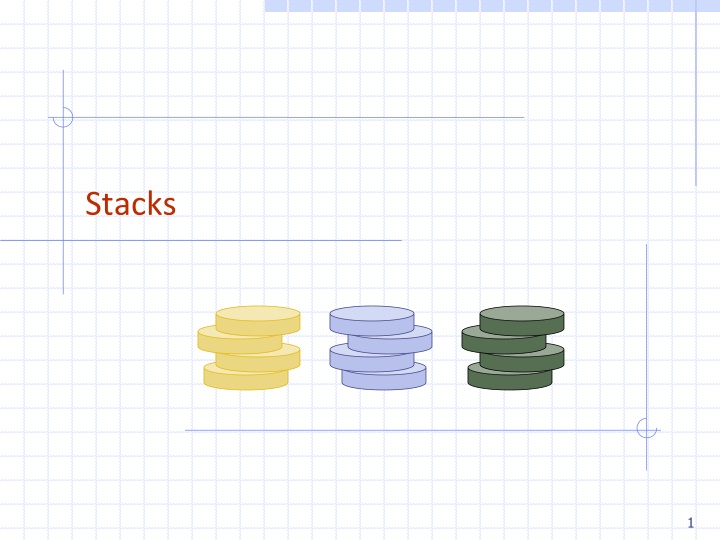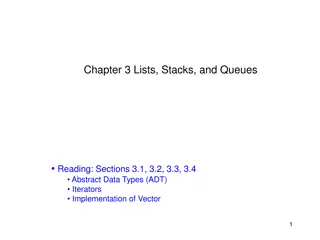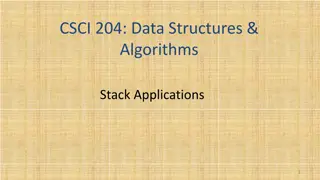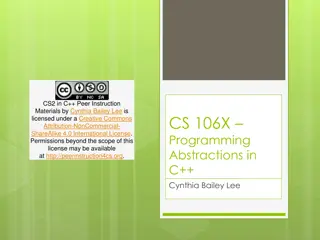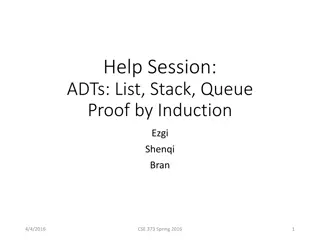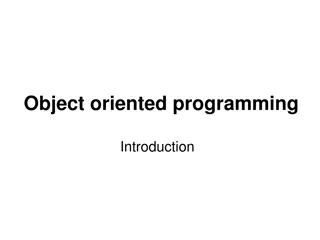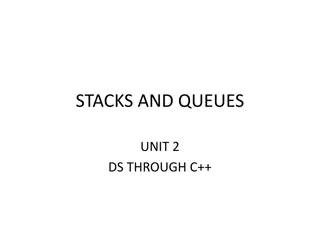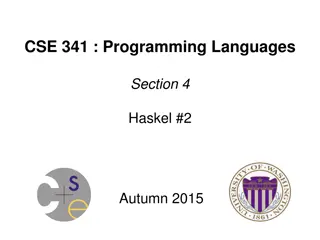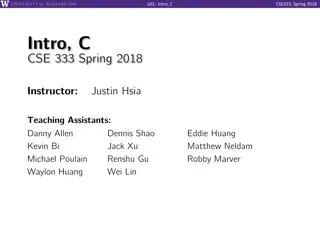Stacks in C++ Programming
Stacks are a fundamental data structure in C++ programming used for various applications like managing function calls and undo sequences. The Last-In-First-Out (LIFO) nature of stacks allows for efficient storage and retrieval of data. Learn about the Stack Abstract Data Type (ADT), stack operations, applications of stacks, and the C++ interface for stack implementation in this comprehensive overview.
Uploaded on Mar 21, 2025 | 2 Views
Download Presentation

Please find below an Image/Link to download the presentation.
The content on the website is provided AS IS for your information and personal use only. It may not be sold, licensed, or shared on other websites without obtaining consent from the author.If you encounter any issues during the download, it is possible that the publisher has removed the file from their server.
You are allowed to download the files provided on this website for personal or commercial use, subject to the condition that they are used lawfully. All files are the property of their respective owners.
The content on the website is provided AS IS for your information and personal use only. It may not be sold, licensed, or shared on other websites without obtaining consent from the author.
E N D
Presentation Transcript
Stacks 1
Example: Algorithm on an Example Expression Operator has lower precedence than +/ 14 4 3 * 2 + 7 4 14 3 4 * $ $ $ 7 -2 14 F + 5 + 14 14 + 2 3 4 2 3 4 * * 6 4 -2 + 14 14 14 14 2
Overview and Reading Reading: Chapter 5.1 Last-In-First-Out Data Structure 3
The Stack ADT The Stack ADT stores arbitrary objects Insertions and deletions follow the last-in first-out scheme Think of a spring-loaded plate dispenser Main stack operations: push(object): inserts an element object pop(): removes the last inserted element Auxiliary stack operations: object top(): returns the last inserted element without removing it integer size(): returns the number of elements stored boolean empty(): indicates whether no elements are stored 4
Stack Interface in C++ C++ interface corresponding to our Stack ADT template <typename E> class Stack { public: int size() const; bool empty() const; const E& top() const throw(StackEmpty); void push(const E& e); void pop() throw(StackEmpty); } Uses an exception class StackEmpty Different from the built-in C++ STL class stack STL: Standard Template Library 5
Applications of Stacks Direct applications Page-visited history in a Web browser Undo sequence in a text editor Chain of method calls in the C++ run-time system Indirect applications Auxiliary data structure for algorithms Component of other data structures 6
Example: C++ Run-Time Stack The C++ run-time system keeps track of the chain of active functions with a stack main() { int i = 5; foo(i); } bar PC = 1 m = 6 When a function is called, the system pushes on the stack a frame containing Local variables and return value Program counter, keeping track of the statement being executed foo(int j) { int k; k = j+1; bar(k); } foo PC = 3 j = 5 k = 6 When the function ends, its frame is popped from the stack and control is passed to the function on top of the stack main PC = 2 i = 5 Allows for recursion bar(int m) { } PC: Program Counter 7
Example Implementation: Array-based Stack A simple way of implementing the Stack ADT uses an array We add elements from left to right A variable keeps track of the index of the top element 8
Example Implementation: Array-based Stack A simple way of implementing the Stack ADT Add elements from left to right A variable keeps track of the index of the top element The array storing the stack elements may become full A push operation will then throw a StackFull exception Limitation of the array-based implementation Not intrinsic to the Stack ADT 9
Performance and Limitations Performance Let n be the number of elements in the stack The space used is O(n) Each operation runs in time O(1) Limitations The maximum size of the stack must be defined a priori and cannot be changed Trying to push a new element into a full stack causes an implementation-specific exception Linked-list based Stack in the text (Chapter 5.1.5) 10
Array-based Stack in C++ template <typename E> class ArrayStack { private: E* S; // array holding the stack int cap; // capacity int t; // index of top element public: // constructor given capacity ArrayStack(int c) : S(new E[c]), cap(c), t(-1) { } void pop() { if (empty()) throw StackEmpty ( Pop from empty stack ); t--; } void push(const E& e) { if (size() == cap) throw StackFull( Push to full stack ); S[++ t] = e; } (other methods of Stack interface) 11
Example use in C++ * indicates top ArrayStack<int> A; // A = [ ], size = 0 A.push(7); // A = [7*], size = 1 A.push(13); // A = [7, 13*], size = 2 cout << A.top() << endl; A.pop(); // A = [7*], outputs: 13 A.push(9); // A = [7, 9*], size = 2 cout << A.top() << endl; // A = [7, 9*], outputs: 9 cout << A.top() << endl; A.pop(); // A = [7*], outputs: 9 ArrayStack<string> B(10); // B = [ ], size = 0 B.push("Bob"); // B = [Bob*], size = 1 B.push("Alice"); // B = [Bob, Alice*], size = 2 cout << B.top() << endl; B.pop(); // B = [Bob*], outputs: Alice B.push("Eve"); // B = [Bob, Eve*], size = 2 12
Example: Parentheses Matching Each ( , { , or [ must be paired with a matching ) , } , or [ correct: ( )(( )){([( )])} correct: ((( )(( )){([( )])} incorrect: )(( )){([( )])} incorrect: ({[ ])} incorrect: ( Good Programmer Someone who thinks that stack is a good data structure for the above task 14
Example: Computing Spans Given an an array X, the span S[i] of X[i] is the maximum number of consecutive elements X[j] immediately preceding X[i] and such that X[j] X[i] 7 6 5 4 3 2 1 Spans have applications to financial analysis 0 0 1 2 3 4 E.g., stock at 52-week high X S 6 1 3 1 4 2 5 3 2 1 15
Algorithm: span1 i X S 6 1 3 1 4 2 5 3 2 1 Loop over i = 0, 1, 2, 3, 4 For each i, compute S[i]. How? From X[i] downward on, compute the number of elements which are consecutively smaller than X[i] 16
Quadratic Algorithm Algorithmspans1(X, n) Input array X of n integers Output array S of spans of X S new array of n integers fori 0 ton 1 do s 1 while s i X[i s] X[i] s s+ 1 S[i] s returnS 1 + 2 + + (n 1) 1 + 2 + + (n 1) n 1 # n n n Algorithm spans1 runs in O(n2) time 17
Algorithm: span2 top top top top top 1 1 2 3 Algorithmspans2(X, n) S new array of n integers A new empty stack fori 0 ton 1 do while ( A.empty() X[A.top()] X[i] ) do A.pop() if A.empty() then S[i] i +1 else S[i] i A.top() A.push(i) returnS X S 6 1 3 1 4 2 5 3 2 1 From index 3 to 1, I am sure that X[4] is the consecutive largest . From index 2 to 1, I am sure that X[2] is the consecutive largest . So, please check X[0] after it 4 So, please check X[0] after it 1 2 3 0 Stack for index 18
Computing Spans with a Stack We keep in a stack the indices of the elements visible when looking back We scan the array from left to right Let i be the current index 7 6 5 4 3 We pop indices from the stack until we find index j such that X[i] X[j] We set S[i] i j We push x onto the stack 2 1 0 0 1 2 3 4 5 6 7 19
Linear Algorithm Algorithmspans2(X, n) # S new array of n integers n A new empty stack 1 fori 0 ton 1 do n while ( A.empty() X[A.top()] X[i] ) do n A.pop()n if A.empty() thenn S[i] i +1 n else S[i] i A.top() n A.push(i) n returnS 1 Each index of the array Is pushed into the stack exactly one Is popped from the stack at most once The statements in the while-loop are executed at most n times Algorithm spans2 runs in O(n) time 20
